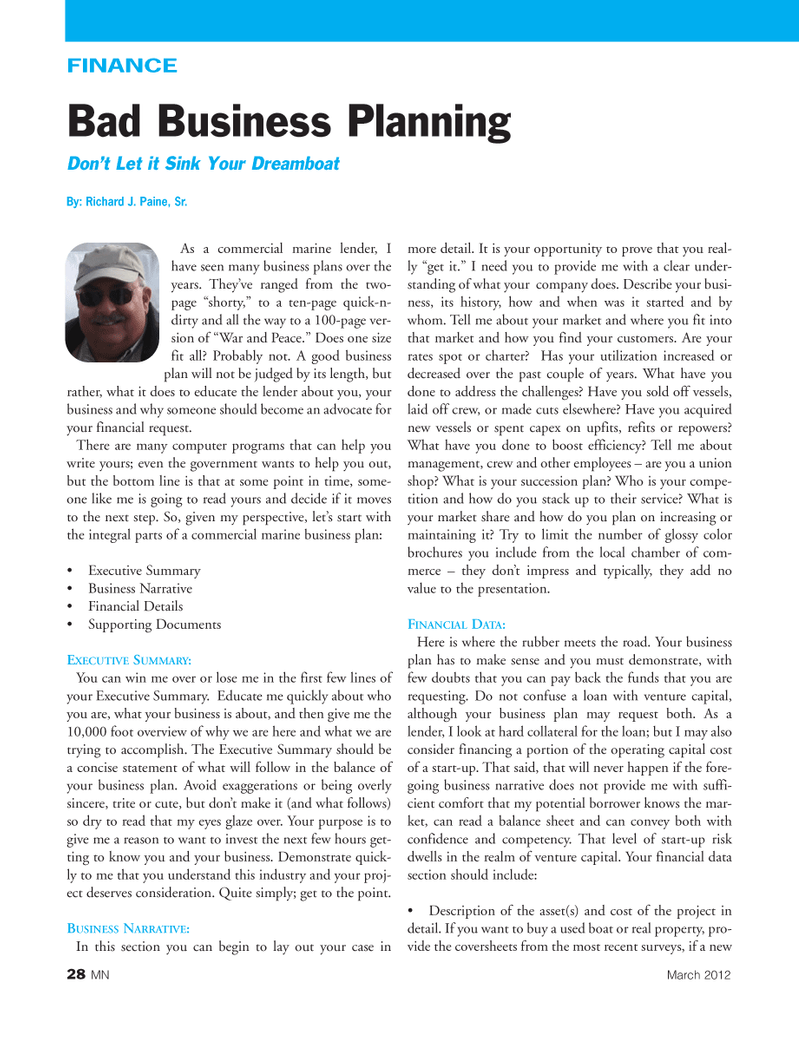
Page 28: of Marine News Magazine (March 2012)
Training & Education
Read this page in Pdf, Flash or Html5 edition of March 2012 Marine News Magazine
28MNMarch 2012 FINANCEAs a commercial marine lender, I have seen many business plans over the years. They?ve ranged from the two- page ?shorty,? to a ten-page quick-n- dirty and all the way to a 100-page ver- sion of ?War and Peace.? Does one size fit all? Probably not. A good business plan will not be judged by its length, but rather, what it does to educate the lender about you, your business and why someone should become an advocate for your financial request. There are many computer programs that can help you write yours; even the government wants to help you out, but the bottom line is that at some point in time, some-one like me is going to read yours and decide if it moves to the next step. So, given my perspective, let?s start with the integral parts of a commercial marine business plan: Executive Summary Business Narrative Financial Details Supporting Documents EXECUTIVESUMMARY :You can win me over or lose me in the first few lines of your Executive Summary. Educate me quickly about who you are, what your business is about, and then give me the 10,000 foot overview of why we are here and what we are trying to accomplish. The Executive Summary should be a concise statement of what will follow in the balance of your business plan. Avoid exaggerations or being overly sincere, trite or cute, but don?t make it (and what follows) so dry to read that my eyes glaze over. Your purpose is to give me a reason to want to invest the next few hours get- ting to know you and your business. Demonstrate quick- ly to me that you understand this industry and your proj- ect deserves consideration. Quite simply; get to the point. BUSINESSNARRATIVE :In this section you can begin to lay out your case in more detail. It is your opportunity to prove that you real- ly ?get it.? I need you to provide me with a clear under- standing of what your company does. Describe your busi- ness, its history, how and when was it started and by whom. Tell me about your market and where you fit into that market and how you find your customers. Are your rates spot or charter? Has your utilization increased or decreased over the past couple of years. What have you done to address the challenges? Have you sold off vessels, laid off crew, or made cuts elsewhere? Have you acquired new vessels or spent capex on upfits, refits or repowers? What have you done to boost efficiency? Tell me about management, crew and other employees ? are you a union shop? What is your succession plan? Who is your compe- tition and how do you stack up to their service? What is your market share and how do you plan on increasing or maintaining it? Try to limit the number of glossy color brochures you include from the local chamber of com- merce ? they don?t impress and typically, they add no value to the presentation. FINANCIALDATA :Here is where the rubber meets the road. Your business plan has to make sense and you must demonstrate, withfew doubts that you can pay back the funds that you are requesting. Do not confuse a loan with venture capital, although your business plan may request both. As a lender, I look at hard collateral for the loan; but I may also consider financing a portion of the operating capital cost of a start-up. That said, that will never happen if the fore- going business narrative does not provide me with suffi- cient comfort that my potential borrower knows the mar- ket, can read a balance sheet and can convey both with confidence and competency. That level of start-up risk dwells in the realm of venture capital. Your financial data section should include:Description of the asset(s) and cost of the project in detail. If you want to buy a used boat or real property, pro- vide the coversheets from the most recent surveys, if a new By: Richard J. Paine, Sr. Bad Business PlanningDon?t Let it Sink Your DreamboatMN#3 (18-31):MN 2011 Layouts 3/2/2012 9:50 AM Page 28

 27
27

 29
29
